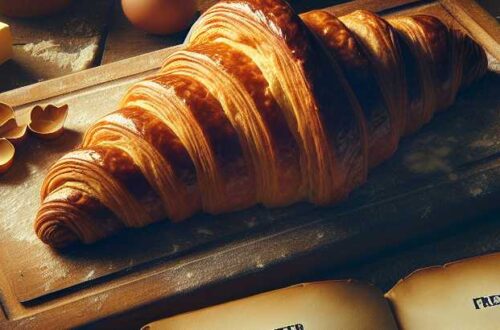How to Achieve Perfectly Flaky Pie Crust

1. Choosing the right ingredients for flaky pie crust
Title: The Great Pie-Crust Conundrum: Choosing the Right Ingredients for Flaky Goodness
When it comes to perfecting your pie game, the crust is everything. All you want is a pie crust so flaky, so tender, and so golden it could be confused for a pastry sunflower in full autumn bloom. However, achieving such a crust is often as elusive as finding a needle in a haystack or a paid parking spot in downtown Manhattan during rush hour! Let’s begin this joyous journey towards pie perfection.
First things first, choosing the right ingredients is crucial as they are the star-studded cast of your pie performance. These prima donnas include flour, fat, liquid, and the unsung hero — salt.
1. Flour Power: All-purpose flour forms the foundation of your pie crust. It’s like the backbone — or funny bone in our case. Without it, you’ll have no crust, and no crust means no pie, which frankly, sounds like the plot of a culinary horror film.
2. Fats: To butter or not to butter — that is the question! Butter delivers in the taste department with richness and gusto, but tends to produce a less flaky texture. Lard is a flaky-favorable choice, but it’s taste is ‘meh’ at best. Shortening has the exact opposite problem – all flake, no flavor. So, what’s our solution? Using a mixture of butter for the taste, and a shorter-fatty friend for perfect flakiness.
“”Howell, in his Familiar Letters, dated from Venice in 1621, says: Not without reason, it being a rare kind of knowledge and chemistry, to transmute the dull bodies of dust and sand, for they are the only ingredients, to such pellucid, dainty body, as we see crystal glass is.””
~ Deming Jarves, Glass-making
This dynamic duo gives you a crust that’s both flaky and flavorful—like the George Clooney of pie crusts!
3. Liquid Love: Ice-cold water is the secret ingredient that binds this magic together. Think of it as the mediator at a family function – it stops the flour and fat from assaulting each other while ensuring they mingle nicely. However, remember – too much liquid can lead to a pie crust that’s harder than trigonometry!
4. A Pinch of Pizazz: Oh, salt, you’re underappreciated. You have no sparkly color, no fantastic smell, not even a proper shape!” Salt might not be the showstopper, but it enhances the flavors, making your crust sing. So, dear bakers, don’t play salt-shy!
So there you have it, wise bakers — flour for structure, fat for texture, water for unity, and salt for flavor! And remember, baking a pie is like playing a piano solo — initially seeming intimidating, but with practice (and some laughs), the music (or in this case, the aroma) just flows.
Just keep the atmosphere light in your kitchen. After all, if an asteroid can handle the pressure, your pie crust certainly can. Now, on with the aprons, off with the oven mitts—there’s a sassy, flaky pie crust waiting to be baked — and eaten!
Read More Here: 1. Choosing The Right Ingredients For Flaky Pie Crust

2. Methods for mixing and chilling dough
Title: Chill Out with Your Dough: The Comedic Kitchen Symphony of Dough Mixing and Chilling
Are you ready to embark on the cuisine cruise of a lifetime? All aboard the fact-filled ferry – destination: Doughland. The delightful sensation of homemade baked dough pleasures the palate, tickles the nostrils, and undoubtedly boogies its way to the heart and soul of many a foodie across the globe. Now, brethren and sistren-of-the-spatula, we present to you the twofold recipe for dough-lightenment: mixing and chilling dough.
To begin, let’s roll into the artful arena of mixing dough. This stage is a wild jamboree of ingredients, akin to a diverse party crashing into your very ordinary, unsuspecting bowl. It’s a joust between flour, sugar, yeast, water and salt, ending in a harmonious marriage of flavors. Think of each ingredient as a different musical instrument. Together, they orchestrate a divine symphony known as— drumroll, please— dough! By the way, if there are a set of bagpipes among the instruments, you’re probably doing something wrong; this is a dough mixing session, not a Scottish gig!
But how do we achieve this magic? The secret to victorious mixing is patience. If you’re a speed demon, yanking your engine and screeching off at the first crack of the dough-mixing pistol, you’ll be in for a rude awakening when your dough turns into a sticky nightmare and snares you like a dough Spiderman’s web. Gentle, consistent stirring does the trick. Balance the dry and wet ingredients graciously. Let them rumble and tumble, producing a smooth, tantalizing dough, positively whispering of delicious things to come.
“[Footnote 14: I have, therefore, been obliged to refer in some detail to these statements, while for those I have already disposed of I have given the references to the _Q.R._ and _E.H.R._] [Footnote 15: _Methods of Historical Study_, p”
~ J.H., Feudal England — Historical Studies On The Eleventh And Twelfth Centuries
Now that your dough has serenely assembled into one harmonious blob, it’s time to place Billy Dough (Oh yes, we’ve named him now!) in the spa for some winter chill vibes. This is where our yeasty companion takes on the marvelous magic of time, temperature, and tranquility.
The almighty refrigerator is your dough’s next stop on its journey to becoming a mouth-watering masterpiece. Why? Because chilling dough is like sending it on a refreshing winter retreat; it allows the flavors to get acquainted, much like old friends huddling around a crackling fire. This process is akin to a reality show, where different ingredients find common grounds, building alliances and plotting against each other in the chilling plot of a refrigerator!
How long should your dough chill? A quick 30-minute power freezing is akin to the espresso shot for dough – good enough for a pick-me-up, yet not sufficient for a full-fledged wake-up call. Ideal dough chilling time ranges anywhere from 2 hours to overnight for the best taste. The chill-out session allows Billy to toughen up, which will help him maintain shape and form when the heat gets turned on in that fiery oven.
Mixing dough is like conducting a symphony, and chilling it, an intermission allowing for the melodies to intertwine gracefully. So, drum up the courage, bake up a storm, and chill out as you journey through the delectable world of dough creation. Just remember, like any good comedy, timing is key. So don’t rush the dough, folks – good things come to those who bake patiently.

3. Ideal baking techniques for perfect flakiness
Title: The Buttah’ Way: 3 Ideal Baking Techniques for Perfect Flakiness
Flaking isn’t considered good behavior unless you’re a golden croissant or a beautiful pie crust. But in the dynamic realm of pastry, flakiness is royalty, the pièce de résistance, the caped-crusader saving the day! It’s the tantalizing tease that makes taste buds dance the samba and sends a surge of satisfaction right to your soul!
Today, we will unveil the three ground-breaking, earth-shattering, mouth-watering techniques to achieve the perfect flakiness your baked goodies rightly deserve. Roll up your sleeves, folks. Things are about to get real flaky, real fast!
1. The Ice Ice Baby Method: Keeping Fat Cold
Forget about Poof and Voilà. Here we embrace the Vanilla Ice mantra, Ice Ice Baby! When it comes to flaky pastries, chilled butter or shortening is our BFF (Best Flaky Friend). A chilly chunk of fat, when integrated with your dough, forms layers upon layers of dough and fat. When baked, the fat melts, creating steam that puffs the dough, and leaves it perfectly flaky and crisp. Now, who said ‘chill’ and ‘steam’ can’t strike up a friendship, huh?
Here’s a hot tip for our ‘cool’ method: When mixing your dough, ensure those fat bits remain like tiny pebbles rather than becoming a homogenous mixture. It’s similar to a summer blockbuster featuring Dwayne Johnson – you want to see those ‘rocks’ in the dough!
2. The No Knead for Speed: Gentle Mixing
Whoa, cowboy! Slow down there.
“_Note:_ Today, in the 1960s, the techniques of frequency division and electronics could be used for transmitting three different line conditions from a group of four different frequencies”
~
Edward Ernst Kleinschmidt, Printing Telegraphy… A New Era Begins
When blending dough for flaky pastries, less is definitely more. No tough love here, please. Contrary to kneading bread, pounding away at your pastry dough won’t earn you any brownie points. Being gentle with the dough helps maintain those tasty layers of fat and flour that will later transpire into flakes of heavenly goodness.
As master bakers say, treat your dough like a first date, nice, attentive, and gentle. Remember, we’re aiming for flaky, not chewy!
3. The Layer Player: Laminating Dough
The term ‘laminating’ may give you horrific flashbacks of office paperwork, but in this context, it’s the last step towards flaky nirvana. Laminating involves folding and re-rolling dough multiple times to produce many thin layers of fat and dough. These layers, when presented with the magic of an oven, dramatically puff up to form the tastiest Opera House ever seen, where each layer represents a seat filled with flavor, and the conductor is your longing fork, ready to orchestrate the symphony in your mouth!
This may be a slightly labor-intensive technique, but the crumbly, melt-in-the-mouth symphony of flavors will make every little effort worth it.
Now, with these three tricks up your sleeve, you’re ready to ride the ‘flaky’ wave to bakery fame. Dig out those rolling pins and work that dough. The world needs more damn fine flaky pies! Time to flake it till you make it, my dear bakers!
Like This? Try: 3. Ideal Baking Techniques For Perfect Flakiness





